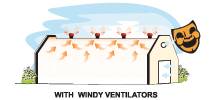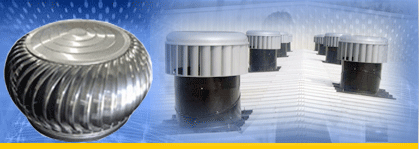«« What ARE Wind Ventilators ? »» |
| |
Wind turbine ventilators are exactly as the name implies, they are a ventilator that is powered by the wind to create effective ventilation for different industries. This product works on wind assisted ventilation. Turbine ventilators are round metal vents with fins in them. Even just a little bit of wind can be just enough for the turbo ventilator to rotate. The faster the wind, the faster the turbine will rotate and exhaust the heat, smoke, fumes, humidity, etc.
The mechanics involved in the air movement is very simple. The hot air inside the shed tends to rise up. When the turbines rotate, they suck the warm air out through the vent, thereby, bringing out a drop in temperature in the shed and allow supply of fresh air through doors and windows.
The size, number and installation all depend on different factors which include wind velocity, temperature differential, environment conditions, and the size of the building. Turbine vents have been vastly used for many years in residential, agriculture, industrial buildings and warehouses.
When it comes to roof top ventilators, they have several advantages which include that they do not need to be powered by electricity, they are located such that they exhaust the hottest air first, they do not cause any harm what so ever to the environment, they tend to save a lot of money because there is no operating cost plus they are maintenance free.
There are different sizes of wind turbo ventilators that range from 14″ to 36″.Due to the fact that they are located at the highest point of the roof, they are able to give off optimum ventilation. They also have to be strong and anti-corrosive. As they are installed on the top of the roof and would come in contact with rain and birds the ventilators are made to be rainwater and bird proof. The ventilators are also designed in a way that prevents leakage and down draft into the building allowing air entry from the side openings.
Ultimately wind turbine ventilators are pleasant looking, and tend to enhance the architectural looks of the building. |
|
| |
«« The Dynamics Of The SVS Turbine Ventilator »» |
| |
|
A well designed turbine ventilator, like the SVS, takes advantage of the wind to create a positive flow through the throat of the ventilator. The wind influences the performance of the ventilator in two ways :
1. As the Wind approaches and strikes the ventilator, it jumps, creating an area of low pressure on the leeward side of the turbine. This low pressure zone is fed by drawing air from the turbine, causing a continuous extraction of air from the building and |
|
2. As the turbine rotates, the
centripetal forces associated with the rotation fling air outwards form the tips of the vanes. Replacement air is drawn into the throat of the ventilator from the building causing continuous ventilation.
|
The SVS turbine will even rotate and exhaust in the absence of wind using the thermal currents developed within the building. |
| |
«« IMPORTANCE OF VENTILATOR DESIGN OR PLACEMENT »» |
As a general rule, hot or stale air will not exhaust through an opening into which wind can blow Therefore, regular static ventilators, which allow outside wind to enter in the shed because of poor design or location on the roof, cannot be expected to exhaust because they backdraft. An efficient means of extracting warm and stale air is through roof mounted turbo ventilators, which create positive draft. Adequate low level provision for the entry of fresh air at ambient temperature should be provided. |
| |
«« Regular Static Ventilators »» |
|
|
|
Monitor roof / jack roof |
Poorly designed ridge / gravent ventilator |
Receives no assistance from the wind. Back draft restricts exhaust of air from bulding. |
Do not promote adequate ventilation or air movement in building. Design can allow entry of rain. |
|
|
| |
«« Roof mounted turbo Ventilators »» |
|
|
Good Ventilation |
Efficient turbine ventilators exhaust hot and stale air and provide a given number of air changes per hour for the building. Does not allow entry of rain. |
| |
«« SVS TURBINE VENTILATORS PROMOTE »» |
|
|

 |
|
Healthy living |
|
Reduction in maintenance of plant & machinery by reduction humidity level |
|
Use of renewable source of wind energy |
|
Increase in Productivity. |
|
Increased life of roofing sheets. |
|
Achievement standards. |
|
|
| |
|
| |
|
 |
|
«« Comparison of Wind Ventilators with Electric
Powered Ventilators »» |
Electric Powered Exhaust Fans |
Wind Powered "SVS" Turbine Ventilators |
Runs on electric power hence high running power cost |
Runs on free wind power hence zero running power cost |
Can be installed only where electric power is available |
Can be installed anywhere as it runs on wind power |
Wall installation prevents uniform ventilation |
Rooftop installation ensures uniform ventilation |
|
80% depreciation available as per income tax rules. |
|
Low payback period |
|
|




